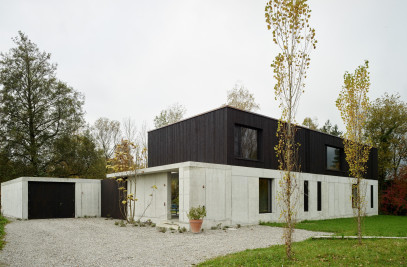The new football stadium is located in Northern part of the city of Lausanne, at the point where the city's dense urban fabric gives way to the more open countryside.The sports infrastructure at the new "Centre sportif de la Tuilière" comprises nine football pitches, arranged in two rows,in addition toan athletics facility with a training centre. The stadium picks up on the idea of the slightly offset rectangular pitches, taking it even further. Positioned at a slight angle to the training pitches, the stadium squareis orchestrated to form the city-side entry point to thesports campus.
The new football stadium isintended exclusively for football matches and major events, with no peripheral uses. Its limiteddeployment and its location on the outskirts of the city permit adesign focused fully on the stadium as a sports facility. With its distinctive, unforgettable structure, it serves as a carrier of identity and memories. Its architecture emotionalises with the steep standsbringing spectators right up to the action on the pitch and the low roof amplifying the background noise of the chanting fans. The architecture thus contributes in no small way to boosting the team's home advantage through its structural measures. The building, history and identity of "FC Lausanne-Sport" are all to merge intoa single whole.
Folding back the four corners of the stadiumenables the design to be tailored to the confined spaceon the site. Theingenious corner solution permits a generous free flow of visitors around the building at ground-floor level, linking the stadium square to its surrounding areas. At the same time, it creates a covered public spaceto serve as a go-between, reconcilingthe outside withthe insideandthe city with the football stadium. The corners simultaneously serve as entrance areas, providing initial glimpses of the pitch and allowing the atmosphere in the stadium to bealready savoured from the outside.
The folded back corners also lend the stadium the impressive, unmistakeable and even iconic lookof a convex vessel, indicative ofits use and what lies within.This distinctive shapeadditionally has a roleto play in the building's staticsby the corners exerting tensile stress on the ring girders running around the top edge of the stadium, imparting rigidity to the four outside walls. In the plinth area, the four corners are linked by a single-storey concrete band. This putsthe finishing touch to the aesthetics of the stadium's outer shell.In functional and visual terms, this "curtain wall" separates the ancillary functions on the ground floor, which includecatering, circulation and loungezones, from the surrounding area, integrating them in the building.
Inscribed within this outer shell is a second, inner shell, shaped by the geometry of the stands. "Mouth holes" cut outof the stands provideaccess to the innermost zone. The space between the two shells islike a resonance box, amplifyingthe happenings on the pitch: a place of anticipation, exchange and encounters. On the narrow sides of these spaces, the gaze is drawn to the stepped inner sides of the corners. These provide further access from the entry level to the walkway around the top, thus generating additionalfunctional value. The walkway is formed by the tensioned girdersmentionedabove, connecting the four corners of the building. The change in design at this point, from heavy concrete in the lower sectionto a slender steel structure above, highlights the walkway in architectural termsas well. Especially during major events without spectator segregation, it invites visitors to access their seat via different routes gaining new perspectives. It is clear here that the topmost point has been reached. The view extendsin all directions, offering a breathtaking panorama over the city of Lausanne, Lake Geneva and the Alps.
While the stadium boasts with a spectacular exterior and splendid views fromits intermediate zone, the lines on the inside exude tranquillity. It is the pitch and the protagonists acting on it that take over the dramaturgy here. Nothing which could cause distraction was added, eventhe seating rows run horizontally round the corners. The vomitoriesemerging from the inner shell blend into the picturealmost completely calm. Even the business and VIP zonesare matched to thegeometry of the seating. Everything isin servitude to the stadium's purpose: the game.
On theoutside, the geometry of the beams and the underside of the standsdominate the stadium on three sides. The west side, by contrast, houses the main stand withits specific uses. The various cloakrooms, press and VIP zones are visibleover three floors through a filigreeglass skin. Gentle creases between the vertically configured strips of glassenhance the impression that this façade isjust a light glass curtain. Its fragmented reflections break up the vast scale of the building. This entire complex not only serves as a backdrop to a new city square but also creates a prominent new address for the city of Lausanne.
The areas around the football stadium blend into the "Plaines-du-loup" landscape above the city of Lausanne. The adjacent airport, the small "petit Flon" river and the accompanyingbushes and shrubs deliver the contextual setting. The green volumes of several groupings of trees form a counterpoint to the stadium building and thesports fields. Natural meadows and wild shrubsextend the natural park, with the generously dimensioned green areas defining the open space towards the new stadium.


































